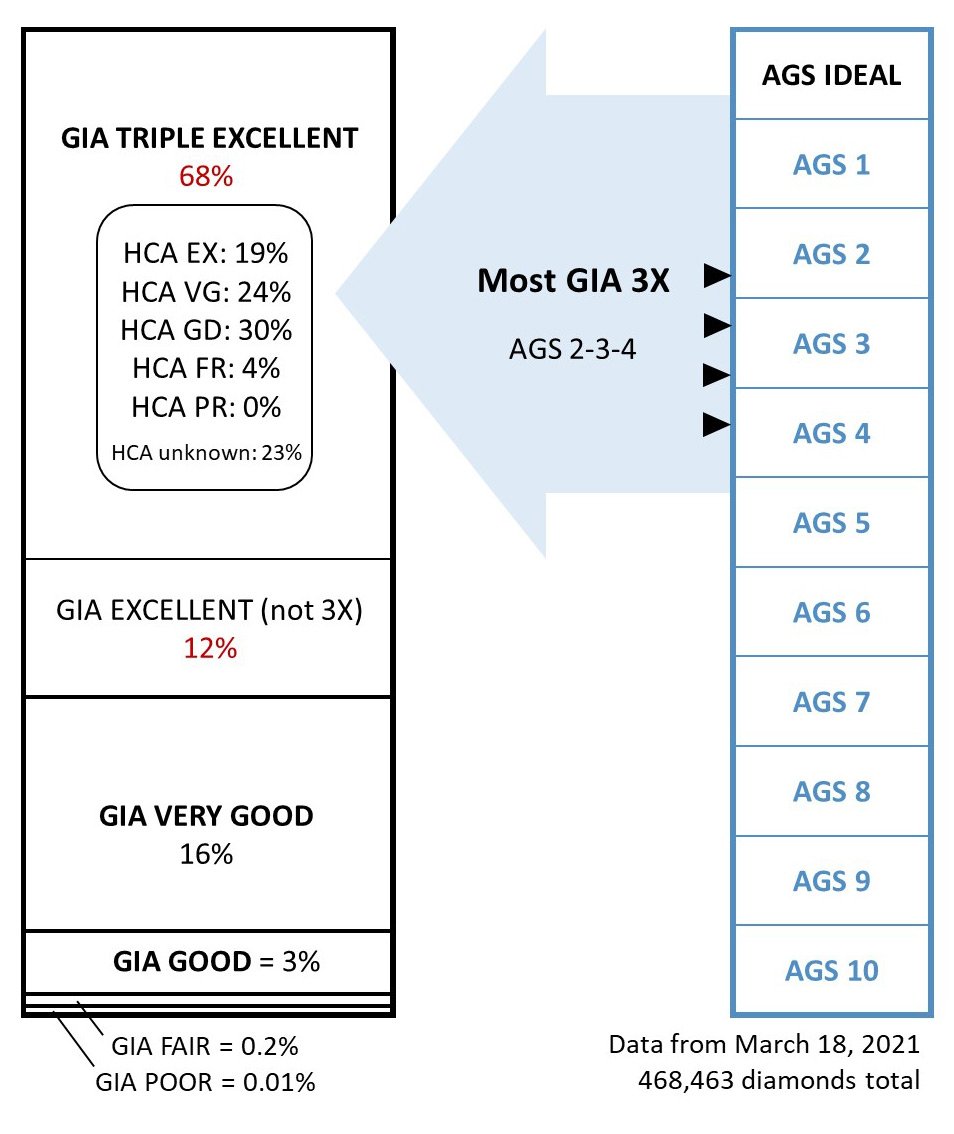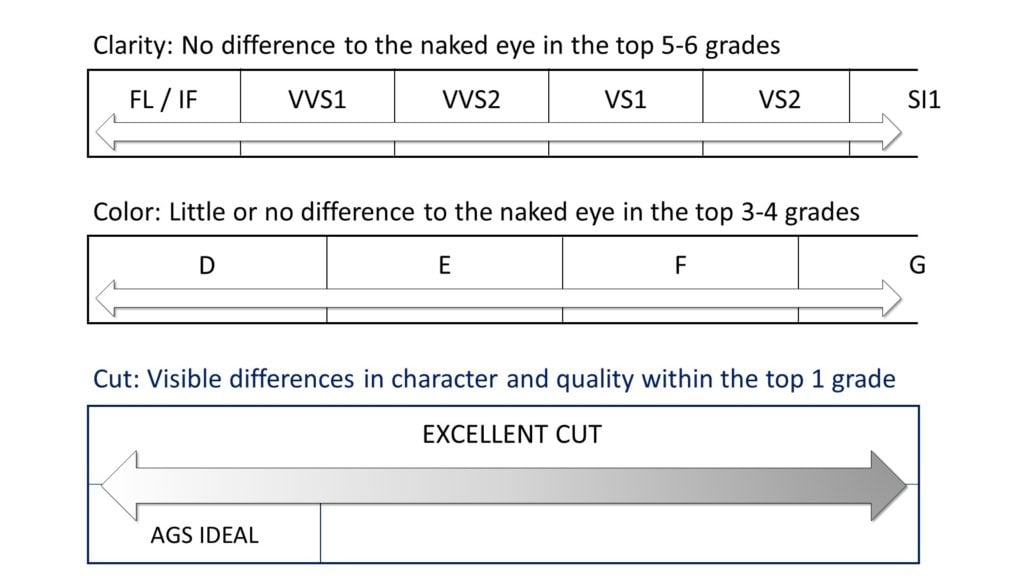Diamond Ratings: Real World Information
Even the top-tier laboratories have launched, revised, introduced and re-introduced diamond ratings systems for cut quality over a dozen times, with no uniform approach. Some use arbitrary systems, others use repeatable science. The one thing they have in common is a far softer approach to judging cut-quality than to grading the natural Cs of color and clarity.
PriceScope Diamond Ratings Chart
PriceScope lists hundreds of thousands of diamonds offered by reputable, vetted vendors, including the most recognized e-commerce sellers in the world. We periodically update the diamond ratings chart below, which shows the distribution of GIA graded diamonds (the most abundant) applied to different ratings systems.
Diamond ratings chart data from March 18, 2021: 468,463 diamonds total.

HCA Diamond Ratings
Reliably, more than half the diamonds GIA grades receive their highest cut grade of Excellent, yet only around 20% pass the patented Holloway Cut Advisor analysis.
AGS Diamond Ratings
Statistically, a GIA Excellent diamond may be rated anywhere between AGS Ideal (AGS 0) and AGS 5 in performance, if graded using the AGS Platinum Report. To predict where a given GIA Excellent falls requires details of spread, proportions, and angles. But facet-group data is averaged and further rounded up or down, so definitive predictions aren’t possible. Moreover, no measure or analysis of 3D optical precision is provided. In general terms the proportions most frequently used producers submitting diamonds to GIA correlate to AGS 2-4, and sometimes AGS 5 in performance, because those cutting angles produces a heavier diamond.
Hypothetical comparison
From a percentage standpoint, if GIA were to treat color grading like cut grading, all diamonds DEFGHIJKLMNO would receive Excellent in color. PQRSTUV would get Very Good and only WXYZ would be Good, Fair or Poor.
Diamond Ratings
People frequently ask why diamond ratings for cut are so wide and permissive, compared to diamond ratings systems for color and clarity.
1. The Diamond Tradition
For over 100 years producers were not held accountable to a cut quality standard. In fact, if you were born before 2006 you were living during a time when GIA was grading only 3Cs and the impact of cut on appearance was ignored. This lack of diamond ratings kept producers happy but was a glaring disservice to consumers.
When the internet opened to the public in 1991 there came an increasing outcry for cut assessment, so the American Gem Society developed a diamond ratings system for cut quality and opened a lab in 1996. The AGSL was considered nerdy and niche (and still is). Then and now, the major diamonds producers send only a fraction of diamonds to AGSL. That fraction is proportionate to the niche audience of performance-focused jewelers who care, and consumers research the topic.
Bottom line: prior to 2006, there was no commercial reason for major producers to give attention to cut quality improvement.
2. The Steep Deep Era
The parameters GIA introduced in 2006 for cut grading round brilliants changed diamond production. Their diamond ratings system penalized shallow stones, so producers shifted their output to much steeper and deeper proportions sets. Today producers avoid shallow production when possible and even beautiful 60-60 style diamonds (with shallow crowns) have nearly disappeared. Meanwhile, diamonds cut with pavilion angles over 41 degrees combined with crown angles over 35 degrees have exploded onto the scene, since the GIA diamond ratings system for cut allows them in the top “excellent” grade.
Bottom line: Major producers plan many diamonds to reach the minimal threshold of the “excellent” cut grade with angles which maximize weight at the expense of brightness. We are in the Steep Deep Era of round brilliants.
3. Producers Game the System
The GIA cut grading system was developed using human observations. It now applies rounded averages to lookup charts. Over time producers have learned to game this system.
- One diamond’s eight crown facets could be cut to a tight group of 34.4, 34.4, 34.4, 34.5, 34.5, 34.6, 34.6, 34.6 and the GIA report will read 34.5.
- Another diamond could be churned out at 34.1, 34.3, 34.5, 34.5, 34.6, 34.8, 34.9, 35.0 and (guess what) the GIA report will also read 34.5.
Producers know they need only hit the averages – which get further rounded – to make the target grade. There is no motivation to keep all angles close and improve optical precision (which would intensify brightness and dispersion). Technology and diamond cutting tools have improved, so there has been an increase in overall consistency, yet the steeper-deeper targets have resulted in a reduction of overall brightness.
Bottom line: Most people have only seen diamonds produced with weight as a priority. Unless you have made the effort to identify and witness performance focused diamonds you have likely never seen a diamond produced for maximum brightness, fire, and scintillation. They are that rare.













